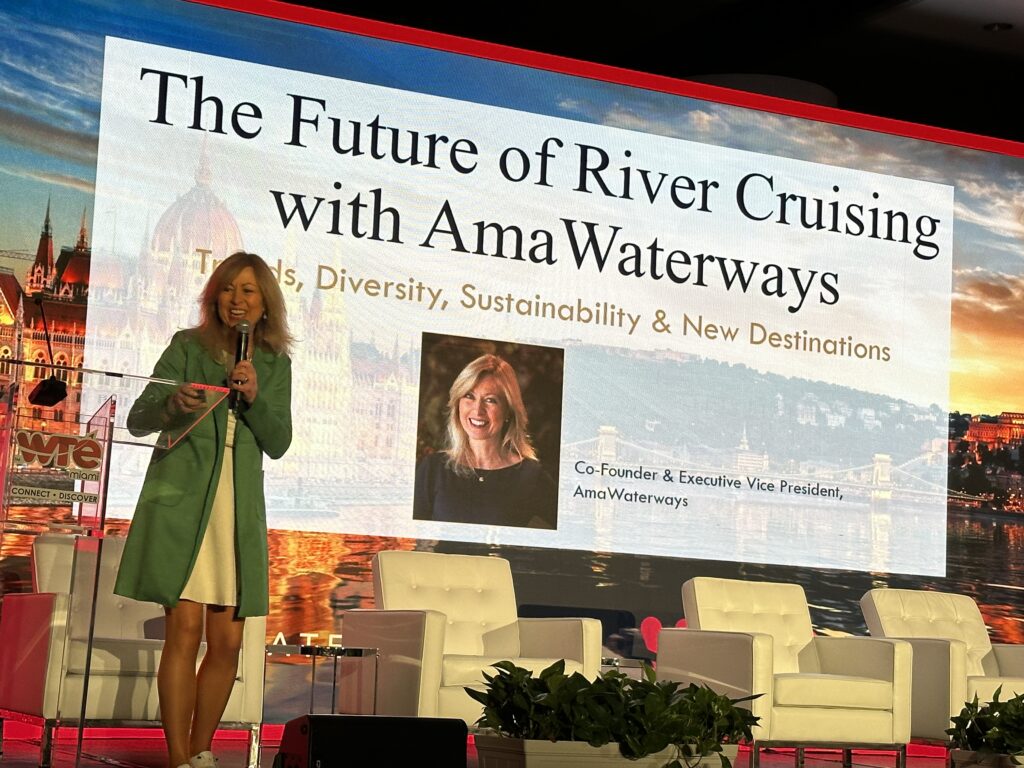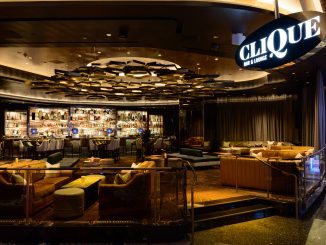
By Gerry Barker
If you’ve never taken a river cruise, just spend five minutes with Kristin Karst, and you’ll be contacting your travel advisor for a booking. As a co-founder of AmaWaterways, a leader in river cruising for over 20 years, her enthusiasm and belief that it’s the best vacation experience going is infectious.

At the World Travel Expo in Miami, held June 13-15, Ms. Karst talked about both the merits of taking a river cruise and what sets AmaWaterways apart from others in the space.
“We are like a floating boutique hotel that takes you from one beautiful city to another,” she said, “passing vineyards, churches and castles on the hills so you have these quaint, magical things right in front of you.”
And unlike oceans cruises on today’s megaships, not only do they not have big crowds, but also “every day is a see day, not a sea day.” In fact, most AmaWaterways cruises have less than 150 guests. Their largest ship, the AmaMagna, is a doublewide that accommodates 195, and one of the first river ships to add a Pickleball court.
But the key difference between river and ocean cruising? “Oceans take you to destinations,” she says,” while rivers take you through destinations.”
Ms. Karst and her husband, Rudi Schreiner — widely regarded as the godfather of river cruising — co-founded AmaWaterways with Jimmy Murphy in 2002. Born in Germany, with a degree in Tourism and Hospitality Management, she worked at American Express prior to teaming up to build a fleet of river ships. Today, AmaWaterways boasts 28 ships sailing itineraries in Europe, Asia, Africa and soon, South America.
So what is driving the surge of interest in river cruising? She cited a number of factors, including:
— Guests get to spend more time in each country visited. “We don’t need to tender and frequently our ships are docked in the heart of the cities we visit, and you can walk right off.”
— “The culture and cuisine — everything is right at your fingertips.”
— AmaWaterways cruises are all-inclusive. Food, drinks (including fine wines), Wi-Fi and shore excursions are included, with bicycles available as well — in fact, wellness is another priority.
One point of particular pride for the family-owned cruise line is during the pandemic, they kept all their employees and associates on the payroll. And while many ships eliminated the buffet during COVID, and then brought them back, AmaWaterways decided to eliminate them entirely, opting to go with personal service instead. “Doing this, we also reduced food waste by 25 percent,” said Ms. Karst.
They are also proud of their efforts on sustainability. Ms. Karst noted 20 of their ships have been certified “green,” which gives them, among other things, special docking privileges in cities like Amsterdam. In addition, they utilize a fuel-efficient navigation system on their ships, and will have solar panels on AmaMagna.

But one of the topics Ms. Karst is most excited to talk about is their newest venture in Colombia, South America. Starting next year, AmaWaterways will become the first cruise line to sail the Magdalena River. Two ships — the AmaMagdalena and AmaMelodia — are now under construction there.
“Colombia represents the best of Europe, Africa and Asia,” said Ms. Karst, citing the culture, heritage, cuisine, nature and people. She added, “Colombia is thrilled” with the prospect, noting, “they have been waiting for someone to open the river.”
Both of the new ships are more intimate: The AmaMagdalena with 60 guests, while AmaMelodia is built for 64. Staterooms vary from 237 to 516 sq. ft. and feature both a French and outside balcony.
There are two, seven-night itineraries planned between Cartagena and Barranquilla, each designed to immerse guests in the region’s culture and cuisine. Stops include Mompox. a UNESCO site, and Palenque, the first “free city” in the Americas.
In Europe, their wine theme cruises are consistently popular and regularly sell out. And reflecting the industry trend toward longer sailings, Ms. Karst said more guests are choosing back-to-back cruises.
Along those lines, they now offer a seven-week cruise: 46 nights aboard four ships, visiting 14 countries in Europe.
Travel advisors play a key role for them, providing 95 percent of their business. But most important of all, Ms. Karst said, are its employees. “No matter what we do or where we go, it’s about the people.”
If their employees are just half as excited as Ms. Karst about river cruising, it’s easy to see they’ll be around for a long time.




Be the first to comment